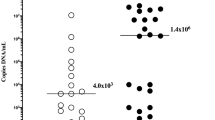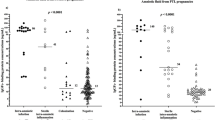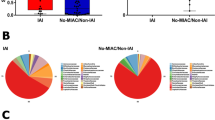Abstract
Objective:
The objective of this study was to evaluate the association of amniotic fluid lactate dehydrogenase and glucose concentrations with microbial invasion of amniotic cavity and histologic chorioamnionitis before 37 pregnancy weeks in women with or without preterm premature rupture of membranes.
Study Design:
Amniocentesis was performed on 70 women with suspected intra-amniotic infection. Standard biochemical methods, molecular microbiology and culture techniques were used. Histopathological examination of the placenta was performed.
Results:
Thirty (48%) women had microbial invasion of the amniotic cavity (MIAC), 53 (76%) women had histological chorioamnionitis and 28 women had both. The cutoff values for MIAC and histological chorioamnionitis were 429 IU l−1 for lactate dehydrogenase and 0.7 mmol l−1 for glucose. Both end points occurred equally often regardless of the membrane status.
Conclusion:
Increased amniotic fluid lactate dehydrogenase and decreased glucose were associated with MIAC and histological chorioamnionitis. However, test performance was of limited value.
This is a preview of subscription content, access via your institution
Access options
Subscribe to this journal
Receive 12 print issues and online access
$259.00 per year
only $21.58 per issue
Buy this article
- Purchase on Springer Link
- Instant access to full article PDF
Prices may be subject to local taxes which are calculated during checkout




Similar content being viewed by others
References
Wu HC, Shen CM, Wu YY, Yuh YS, Kua KE . Subclinical histologic chorioamnionitis and related clinical and laboratory parameters in preterm deliveries. Pediatr Neonatol 2009; 50: 217–221.
Goldenberg RL, Culhane JF, Iams JD, Romero R . Epidemiology and causes of preterm birth. Lancet 2008; 371: 75–84.
Roescher AM, Timmer A, Erwich JJ, Bos AF . Placental pathology, perinatal death, neonatal outcome, and neurological development: a systematic review. PLoS One 2014; 9: e89419.
Garcia-Munoz Rodrigo F, Galan Henriquez GM, Ospina CG . Morbidity and mortality among very-low-birth-weight infants born to mothers with clinical chorioamnionitis. Pediatr Neonatol 2014; 55: 381–386.
Edwards RK . Chorioamnionitis and Labor. Obstet Gynecol Clin North Am 2005; 32: 287–296.
Xie A, Zhang W, Chen M, Wang Y, Wang Y, Zhou Q et al. Related factors and adverse neonatal outcomes in women with preterm premature rupture of membranes complicated by histologic chorioamnionitis. Med Sci Monit 2015; 21: 390–395.
Menon R, Taylor RN, Fortunato SJ . Chorioamnionitis – A complex pathophysiologic syndrome. Placenta 2010; 31: 113–120.
Lahra MM, Jeffery HE . A fetal response to chorioamnionitis is associated with early survival after preterm birth. Am J Obstet Gynecol 2004; 190: 147–151.
Vajrychova M, Kacerovsky M, Tambor V, Hornychova H, Lenco J . Microbial invasion and histological chorioamnionitis upregulate neutrophil-gelatinase associated lipocalin in preterm prelabor rupture of membranes. J Matern Fetal Neonatal Med 2016; 29: 12–21.
Dulay AT, Buhimschi IA, Zhao G, Bahtiyar MO, Thung SF, Cackovic M et al. Compartmentalization of acute phase reactants interleukin-6, C-reactive protein and procalcitonin as biomarkers of intra-amniotic infection and chorioamnionitis. Cytokine 2015; 76: 236–243.
Romero R, Jimenez C, Lohda AK, Nores J, Hanaoka S, Avila C et al. Amniotic fluid glucose concentration: a rapid and simple method for the detection of intraamniotic infection in preterm labor. Am J Obstet Gynecol 1990; 163: 968–974.
Ford C, Genc MR . Optimized amniotic fluid analysis in patients suspected of intrauterine infection/inflammation. J Perinat Med 2011; 40: 33–37.
Buhimschi CS, Bhandari V, Hamar BD, Bahtiyar MO, Zhao G, Sfakianaki AK et al. Proteomic profiling of the amniotic fluid to detect inflammation, infection, and neonatal sepsis. PLoS Med 2007; 4: e18.
Romero R, Miranda J, Chaiworapongsa T, Chaemsaithong P, Gotsch F, Dong Z et al. A novel molecular microbiologic technique for the rapid diagnosis of microbial invasion of the amniotic cavity and intra-amniotic infection in preterm labor with intact membranes. Am J Reprod Immunol 2014; 71: 330–358.
Pettker CM, Buhimschi IA, Magloire LK, Sfakianaki AK, Hamar BD, Buhimschi CS . Value of placental microbial evaluation in diagnosing intra-amniotic infection. Obstet Gynecol 2007; 109: 739–749.
DiGiulio DB, Romero R, Kusanovic JP, Gomez R, Kim CJ, Seok KS et al. Prevalence and diversity of microbes in the amniotic fluid, the fetal inflammatory response, and pregnancy outcome in women with preterm pre-labor rupture of membranes. Am J Reprod Immunol 2010; 64: 38–57.
Payne MS, Bayatibojakhi S . Exploring preterm birth as a polymicrobial disease: an overview of the uterine microbiome. Front Immunol 2014; 5: 595.
Gervasi MT, Romero R, Bracalente G, Chaiworapongsa T, Erez O, Dong Z et al. Viral invasion of the amniotic cavity (VIAC) in the midtrimester of pregnancy. J Matern Fetal Neonatal Med 2012; 25: 2002–2013.
Romero R, Miranda J, Chaiworapongsa T, Korzeniewski SJ, Chaemsaithong P, Gotsch F et al. Prevalence and clinical significance of sterile intra-amniotic inflammation in patients with preterm labor and intact membranes. Am J Reprod Immunol 2014; 72: 458–474.
Kim CJ, Romero R, Chaemsaithong P, Chaiyasit N, Yoon BH, Kim YM . Acute chorioamnionitis and funisitis: definition, pathologic features, and clinical significance. Am J Obstet Gynecol 2015; 213 (4 Suppl): S29–S52.
Hitti J, Tarczy-Hornoch P, Murphy J, Hillier SL, Aura J, Eschenbach DA . Amniotic fluid infection, cytokines, and adverse outcome among infants at 34 weeks' gestation or less. Obstet Gynecol 2001; 98: 1080–1088.
Porreco RP, Heyborne KD, Shapiro H . Amniocentesis in the management of preterm premature rupture of the membranes: a retrospective cohort analysis. J Matern Fetal Neonatal Med 2008; 21: 573–579.
Maki Y, Furukawa S, Kodama Y, Sameshima H, Ikenoue T . Amniocentesis for threatened preterm labor with intact membranes and the impact on adverse outcome in infants born at 22 to 28 weeks of gestation. Early Hum Dev 2015; 91: 333–337.
Shinjo A, Otsuki K, Sawada M, Ota H, Tokunaka M, Oba T et al. Retrospective cohort study: a comparison of two different management strategies in patients with preterm premature rupture of membranes. Arch Gynecol Obstet 2012; 286: 337–345.
Akolekar R, Beta J, Picciarelli G, Ogilvie C, D'Antonio F . Procedure-related risk of miscarriage following amniocentesis and chorionic villus sampling: a systematic review and meta-analysis. Ultrasound Obstet Gynecol 2015; 45: 16–26.
Yeast JD, Garite TJ, Dorchester W . The risks of amniocentesis in the management of premature rupture of the membranes. Am J Obstet Gynecol 1984; 149: 505–508.
Lee SY, Park KH, Jeong EH, Oh KJ, Ryu A, Kim A . Intra-amniotic infection/inflammation as a risk factor for subsequent ruptured membranes after clinically indicated amniocentesis in preterm labor. J Korean Med Sci 2013; 28: 1226–1232.
Garry D, Figueroa R, Aguero-Rosenfeld M, Martinez E, Visintainer P, Tejani N . A comparison of rapid amniotic fluid markers in the prediction of microbial invasion of the uterine cavity and preterm delivery. Obstet Gynecol 1996; 175: 1336–1341.
Buhimschi CS, Buhimschi IA, Abdel-Razeq S, Rosenberg VA, Thung SF, Zhao G et al. Proteomic biomarkers of intra-amniotic inflammation: relationship with funisitis and early-onset sepsis in the premature neonate. Pediatr Res 2007; 61: 318–324.
Dulay AT, Buhimschi CS, Zhao G, Oliver EA, Mbele A, Jing S et al. Soluble TLR2 is present in human amniotic fluid and modulates the intraamniotic inflammatory response to infection. J Immunol 2009; 182: 7244–7253.
Kidokoro K, Furuhashi M, Kuno N, Ishikawa K . Amniotic fluid neutrophil elastase and lactate dehydrogenase: association with histologic chorioamnionitis. Acta Obstet Gynecol Scand 2006; 85: 669–674.
Gauthier DW, Meyer WJ, Bieniarz A . Correlation of amniotic fluid glucose concentration and intraamniotic infection in patients with preterm labor or premature rupture of membranes. Am J Obstet Gynecol 1991; 165: 1105–1110.
Odibo AO, Rodis JF, Sanders MM, Borgida AF, Wilson M, Egan JF et al. Relationship of amniotic fluid markers of intra-amniotic infection with histopathology in cases of preterm labor with intact membranes. J Perinatol 1999; 19: 407–412.
Greig PC, Ernest JM, Teot L . Low amniotic fluid glucose levels are a specific but not a sensitive marker for subclinical intrauterine infections in patients in preterm labor with intact membranes. Am J Obstet Gynecol 1994; 171: 365–370 discussion 370-1.
Romero R, Miranda J, Chaemsaithong P, Chaiworapongsa T, Kusanovic JP, Dong Z et al. Sterile and microbial-associated intra-amniotic inflammation in preterm prelabor rupture of membranes. J Matern Fetal Neonatal Med 2015; 28: 1394–1409.
Combs CA, Gravett M, Garite TJ, Hickok DE, Lapidus J, Porreco R et al. Amniotic fluid infection, inflammation, and colonization in preterm labor with intact membranes. Am J Obstet Gynecol 2014; 210: 125.e1–125.e15.
Acknowledgements
The study was funded by Helsinki University Hospital Research grant (TYH2013340), by The Finnish Medical Foundation, and by the SalWe Research Program ‘Get it Done’ (Tekes- The Finnish Funding Agency for Technology and Innovation grant 3986/31/2013).
Author information
Authors and Affiliations
Corresponding author
Ethics declarations
Competing interests
The authors declare no conflict of interest.
Rights and permissions
About this article
Cite this article
Myntti, T., Rahkonen, L., Tikkanen, M. et al. Amniotic fluid rapid biomarkers are associated with intra-amniotic infection in preterm pregnancies regardless of the membrane status. J Perinatol 36, 606–611 (2016). https://doi.org/10.1038/jp.2016.59
Received:
Revised:
Accepted:
Published:
Issue Date:
DOI: https://doi.org/10.1038/jp.2016.59
This article is cited by
-
Glucocorticoids, sodium transport mediators, and respiratory distress syndrome in preterm infants
Pediatric Research (2021)
-
Comparison of amniotic fluid matrix metalloproteinase-8 and cathelicidin in the diagnosis of intra-amniotic infection
Journal of Perinatology (2016)



